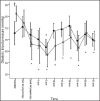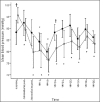Effect of preinduction low-dose ketamine bolus on intra operative and immediate postoperative analgesia requirement in day care surgery: A randomized controlled trial
- PMID: 26543461
- PMCID: PMC4610088
- DOI: 10.4103/1658-354X.159468
Effect of preinduction low-dose ketamine bolus on intra operative and immediate postoperative analgesia requirement in day care surgery: A randomized controlled trial
Abstract
Background: Availability of narcotics is an issue in developing countries, and low-dose ketamine offers an alternative to these drugs.
Objective: The objective of this study is to evaluate the effect of a preemptive dose of low-dose ketamine on intra operative and the immediate postoperative analgesic requirements.
Design: Randomized double-blind control trial.
Settings: This study has been performed in the operating rooms and postanesthesia care unit at Aga Khan University Hospital, Karachi, Pakistan.
Materials and methods: Totally, 60 adult American Society of Anesthesiologists I and II patients undergoing day care surgery were randomly allocated into two groups, Group A (ketamine group) and Group B (saline group).
Intervention: All patients underwent general anesthesia. Propofol 2 mg/kg was used as an induction agent; laryngeal mask airway (size 3 for females and 4 for males) was inserted. Following induction patients in Group A received ketamine 0.3 mg/kg and Group B saline bolus in a blinded manner. All patients were administered injection fentanyl 1 μg/kg as an analgesic and anesthesia was maintained with oxygen 40%, nitrous oxide 60% and isoflorane 1-2 minimum alveolar concentration. Patients breathed spontaneously on Lack circuit. Postoperatively rescue analgesia was provided with intravenous morphine 0.1 mg/kg when patient complained of pain.
Main outcome measures: We observed analgesic effects of low-dose ketamine intra operatively and narcotic requirements in immediate postoperative period for day care surgeries.
Results: There was no significant difference in demographic data in between groups. Saline group required more rescue analgesia (morphine) postoperatively (P < 0.001). No significant psychotomimetic symptoms were noted in either group.
Conclusion: Low-dose ketamine 0.3 mg/kg provided adequate co-analgesia with fentanyl 1 μg/kg and was effective in a reduction of morphine requirement in the postoperative phase with minimal adverse effects.
Keywords: Day care surgery; low-dose ketamine; postoperative analgesia.
Conflict of interest statement
Figures






 ) and saline group (◻◻)
) and saline group (◻◻)References
-
- Rabiner EA. Imaging of striatal dopamine release elicited with NMDA antagonists: Is there anything there to be seen? J Psychopharmacol. 2007;21:253–8. - PubMed
-
- Dickenson AH. Combination therapy in analgesia; seeking synergy. Curr Opin Anesthesiol. 1993;6:861–5.
-
- Hodges SC, Mijumbi C, Okello M, McCormick BA, Walker IA, Wilson IH. Anesthesia services in developing countries: Defining the problems. Anesthesia. 2007;62:4–11. - PubMed
-
- Launo C, Bassi C, Spagnolo L, Badano S, Ricci C, Lizzi A, et al. Preemptive ketamine during general anesthesia for postoperative analgesia in patients undergoing laparoscopic cholecystectomy. Minerva Anestesiol. 2004;70:727–34. - PubMed
LinkOut - more resources
Full Text Sources
Miscellaneous

